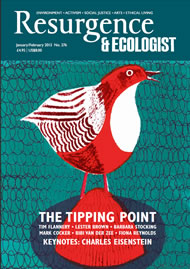In the 1880s, when my great-grandfather ploughed the fertile virgin prairies of eastern Nebraska, the soil contained 100 tonnes of carbon per hectare. The carbon-rich humus had been laid down by millennia of prairie grasses and tree leaves, decomposed by fungi and bacteria, enriched by buffalo droppings and aerated by prairie dogs and rattlesnakes (earthworms hadn’t arrived from Europe yet).
By the 1920s, when the soil no longer had enough humus to support endless cropping with no rotations, along came the tractor. Tractors were able to dig deeper than horse-drawn ploughs and so enabled the farmers ...
There are approximately 1047 more words in this article.
To read the rest of this article, please buy this issue, or join the Resurgence Trust. As a member you will receive access to the complete archive of magazines from May 1966.
If you are already a member, please Sign in






